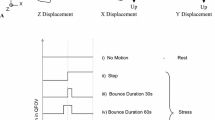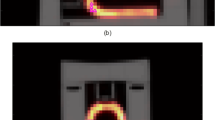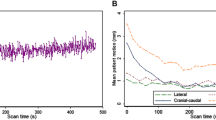Abstract
A solid-state cadmium zinc tellurium (CZT) dedicated multipinhole cardiac camera which acquires all views simultaneously has been introduced for myocardial SPECT acquisition. We report a method to detect and ameliorate patient motion artifacts in myocardial perfusion imaging (MPI) studies recorded with this device. To detect motion, a myocardial phantom study was recorded, and at mid-scan, the phantom was moved stepwise along each of 6 orthogonal directions, causing MPI artifacts. Using QPS software (Cedars-Sinai) and an in-house normal database, displacements giving artifactual perfusion defects (total perfusion deficit score, TPD, >5 %) were all 1.5 cm or greater (11.2 ± 1.3 % for 1.5 cm). List mode data were reframed into 10-s steps, and the norm of the changes in center of mass among the 19 projections (32 × 32 matrix, pixel size 2.46 mm) was used as a motion index. Rejection of misregistered data gave artifact-free reconstructions (TPD = 1.0 ± 0.8 %) in phantom scans and reduced blur in a rest/stress clinical study. Blur on the patient’s stress scan was consistent with increased motion compared to rest (motion index of 4.4 vs. 3.0 pixels, respectively). For CZT cameras that acquire data from multiple views simultaneously, motion during MPI can cause clinically significant artifacts. Reframing acquisitions into discrete time intervals enables the detection of motion and its amelioration, improving diagnostic accuracy.







Similar content being viewed by others
Explore related subjects
Discover the latest articles, news and stories from top researchers in related subjects.References
Bai C, Maddahi J, Kindem J, Conwell R, Gurley M, Old R (2009) Development and evaluation of a new fully automatic motion detection and correction technique in cardiac SPECT imaging. J Nucl Cardiol 16(4):580–589
Bocher M, Blevis IM, Tsukerman L, Shrem Y, Kovalski G, Volokh L (2010) A fast cardiac gamma camera with dynamic SPECT capabilities: design, system validation and future potential. Eur J Nucl Med Mol Imaging 37:1887–1902
Büther F, Dawood M, Stegger L, Wübbeling F, Schäfers M, Schober O, Schäfers KP (2009) List mode-driven cardiac and respiratory gating in PET. J Nucl Med 50(5):674–681
Büther F, Ernst I, Dawood M, Kraxner P, Schäfers M, Schober O, Schäfers KP (2010) Detection of respiratory tumour motion using intrinsic list mode-driven gating in positron emission tomography. Eur J Nucl Med Mol Imaging 37:2315–2327
Cooper JA, Neumann PH, McCandless BK (1993) Detection of patient motion during tomographic myocardial perfusion imaging. J Nucl Med 34(8):1341–1348
DePuey EG (2015) Image artifacts. In: Iskandrian AE, Garcia EV (eds) Nuclear cardiac imaging: Principles and applications, 5th edn. Oxford University Press, New York, pp 137–177
Dorbala S, Di Carli MF, Delbeke D, Abbara S, DePuey EG, Dilsizian V, Forrester J, Janowitz W, Kaufmann PA, Mahmarian J, Moore SC, Stabin MG, Shreve P (2013) SNMMI/ASNC/SCCT guideline for cardiac SPECT/CT and PET/CT 1.0*. J Nucl Med 54(8):1485–1507
Eisner R, Churchwell A, Noever T et al (1988) Quantitative analysis of the tomographic thallium-201 myocardial bull’s-eye display: critical role of correcting for patient motion. J Nucl Med 29(1):91–97
Friedman J, Berman DS, VanTrain K, Garcia EV, Bietendorf J, Prigent F et al (1988) Patient motion in thallium-201 myocardial SPECT imaging: an easily identified frequent source of artifactual defect. Clin Nuc Med 13:321–324
Green PJ (1990) Bayesian reconstructions from emission tomography data using a modified EM algorithm. IEEE Trans Med Imaging 9(1):84–93
Hendel RC, Berman DS, Di Carli MF, Heidenreich PA, Henkin RE, Pellikka PA et al (2009) ACCF/ASNC/ACR/AHA/ASE/SCCT/SCMR/SNM 2009 Appropriate use criteria for cardiac radionuclide imaging. J Am Coll Cardiol 53(23):2201–2229
Herzog BA, Buechel RR, Katz R, Brueckner M, Husmann L, Burger IA et al (2010) Nuclear Myocardial Perfusion imaging with a cadmium-zinc-telluride detector technique: optimized protocol for scan time reduction. J Nucl Med 51(1):46–51
Hindorf C, Oddstig J, Hedeer F, Hansson MJ, Jögi J, Engblom H (2014) Importance of correct patient positioning in myocardial perfusion SPECT when using a CZT camera. J Nucl Cardiol 21(4):695–702
Iskandrian AE (2010) Stress-only myocardial perfusion imaging: a new paradigm. J Am Coll Cardiol 55:231–233
Kennedy JA, Brodov Y, Keidar Z, Inbar R, Weinstein AL, Israel O, Frenkel A (2012) Automated summed stress and summed rest scoring for MPI in a dedicated cardiac solid state CZT SPECT device compared to a conventional system. Abstract. Radiological Society of North America 98th Scientific Assembly and Annual Meeting Program, 25–30 Nov 2012; Chicago. LL-NMS-SU2A
Kirch D, Koss J, Steele P (2007) Motion correction (MC) of multi-pinhole SPECT (MP-SPECT) myocardial perfusion imaging (MPI) on a breath-by-breath (BbB) basis improves accuracy in measurement of LV function. J Nucl Med 48(Supplement 2):42P
Ko CL, Wu YW, Cheng MF, Yen RF, Wu WC, Tzen KY (2015) Data-driven respiratory motion tracking and compensation in CZT cameras: a comprehensive analysis of phantom and human images. J Nucl Cardiol 22(2):308–318
Koshino K, Watabe H, Enmi J, Hirano Y, Zeniya T, Hasegawa S et al (2012) Effects of patient movement on measurements of myocardial blood flow and viability in resting 15O-water PET studies. J Nucl Cardiol 19(3):524–533
Kovalski G, Israel O, Keidar Z, Frenkel A, Sachs J, Azhari H (2007) SPECT scans using respiratory gating correction of heart motion due to respiration in clinical myocardial perfusion. J Nucl Med 48(4):630–636
Leslie WD, Dupont JO, McDonald D, Peterdy AE (1997) Comparison of motion correction algorithms for cardiac SPECT. J Nucl Med 38(5):785–790
Lupi A, Zaroccolo M, Salgarello M, Malfatti V, Zanco P (2009) The effect of 18F-FDG-PET/CT respiratory gating on detected metabolic activity in lung lesions. Ann Nucl Med 23:191–196
McQuaid SJ, Hutton BF (2008) Sources of attenuation-correction artefacts in cardiac PET/CT and SPECT/CT. Eur J Nucl Med Mol Imaging 35:1117–1123
Mukherjee JM, McNamara JE, Johnson KL, Dey J, King MA (2009) Estimation of rigid-body and respiratory motion of the heart from marker-tracking data for SPECT motion correction. IEEE Trans Nucl Sci 56(1):147–155
O’Connor MK, Kanal KM, Gebhard MW, Rossman PJ (1998) Comparison of four motion correction techniques in SPECT imaging of the heart: a cardiac phantom study. J Nucl Med 39(12):2027–2034
Pitman AG, Kalff V, Van Every B, Risa B, Barnden LR, Kelly MJ (2002) Effect of mechanically simulated diaphragmatic respiratory motion on myocardial SPECT processed with and without attenuation correction. J Nucl Med 43(9):1259–1267
Slomka PJ, Nishina H, Berman DS, Kang X, Akincioglu C, Friedman JD et al (2004) “Motion-frozen” display and quantification of myocardial perfusion. J Nucl Med 45(7):1128–1134
Slomka PJ, Nishina H, Berman DS, Akincioglu C, Abidov A, Friedman JD et al (2005) Automated quantification of myocardial perfusion SPECT using simplified normal limits. J Nucl Cardiol 12(1):66–77
Slomka PJ, Patton JA, Berman DS, Germano G (2009) Advances in technical aspects of myocardial perfusion SPECT imaging. J Nucl Cardiol 16(2):255–276
Steele PP, Kirch DL, Koss JE (2008) Comparison of simultaneous dual-isotope multipinhole SPECT with rotational SPECT in a group of patients with coronary artery disease. J Nucl Med 49(7):1080–1089
Ter-Pogossian MM, Bergmann SR, Sobel BE (1982) Influence of cardiac and respiratory motion on tomographic reconstructions of the heart: implications for quantitative nuclear cardiology. J Comput Assist Tomogr 6:1148–1155
Timmins R, Terrence D, Ruddy TD, Wells RG (2015) Patient position alters attenuation effects in multipinhole cardiac SPECT. Med Phys 42(3):1233–1240
Wheat JM, Currie GM (2004) Incidence and characterization of patient motion in myocardial perfusion SPECT: part 1. J Nucl Med Technol 32(2):60–65
Woo J, Tamarappoo B, Dey D, Nakazato R, Le Meunier L, Ramesh A et al (2011) Automatic 3D registration of dynamic stress and rest 82Rb and flurpiridaz F 18 myocardial perfusion PET data for patient motion detection and correction. Med Phys 38(11):6313–6326
Author information
Authors and Affiliations
Corresponding author
Rights and permissions
About this article
Cite this article
Kennedy, J.A., William Strauss, H. Motion detection and amelioration in a dedicated cardiac solid-state CZT SPECT device. Med Biol Eng Comput 55, 663–671 (2017). https://doi.org/10.1007/s11517-016-1548-z
Received:
Accepted:
Published:
Issue Date:
DOI: https://doi.org/10.1007/s11517-016-1548-z




